By Rachel Straus
There is no better way to anoint a rising City Ballet male star than to award him the title role in Balanchine’s “Apollo.” On May 5 corps dancer Chase Finlay hit the big time, receiving curtain calls and roars of applause. The 21-year-old looked like a young Nordic god (much the way Ballet Master in Chief Peter Martins did when he first appeared as “Apollo” in 1967). With a Martins-style majesty, Finlay subsumed his new role. Seated and gazing at his dancing Muses—Terpsichore (Sterling Hyltin), Polyhymnia (Tiler Peck) and Calliope (Ana Sophia Scheller)—Finlay captivated in stillness as much as in his boldly vigorous movements.
Beyond Finlay’s debut, Thursday’s programming felt celestial. Beginning the night were the Balanchine-Stravinsky masterworks “Monumentum Pro Gesualdo” (1960) and “Movements for Piano and Orchestra” (1963). Though these short ballets were made three years apart, they became side-by-side companion pieces. While “Monumentum” features choreographic lyricism and equilibrium, “Movements” traffics in cubist asymmetries. In the latter work, the building blocks of classical vocabulary (plie, tendu, fifth position) are interrupted in transit. Spiral movements are forced into right angles. Despite a lack of narrative, principals Maria Kowroski and Sébastian Marcovici plied a psychologically complex relationship. Neither intimates nor strangers, they danced like two people in a coolly impassioned debate. With hands flexed, they seemed to end their conversation at an impasse.
But getting back to Finlay. More should be said about this “Apollo,” which appeared second on the program. In Balanchine’s 1928 ballet, the young god’s moment of benediction comes when his muses perform a unison triple handclap. Then the women open their palms for Apollo to rest his head. When Finlay stood and laid his brow, he looked absolutely relieved, having passed through the work’s most iconic moments. They include the instance when Finlay extends his arms skyward like Michelangelo’s “Vitruvian-Man,” echoing the string instruments’ sonic force. Performing this gesture convincingly requires a Nietzsche-like approach to the self. (“The world itself is the will to power – and nothing else! And you yourself are the will to power – and nothing else!”)
Hopefully, Finlay’s ability to embody youthful absolutism will be confined to the stage. Recently French Vogue featured Finlay half naked in Bruce Webber’s photos. Of equal interest, but of a less salacious sort, is the dancing of principal Sterling Hyltin. Her musical responsiveness and love of moving make her appear triple her size. As Terpsichore, Hyltin was bodily electric.
Another hair-on-arm raising experience were the performances of Balanchine’s “Four Temperaments.” (1946). Seen on May 5 and May 7, the casting was powerfully good. Jennie Somogyi’s dancing in “Sanguinic” possessed a boxer’s controlled strike and the elegance of a leopard in full lope. Gonzalo Garcia’s solo in “Melancholic” was velvety phrased and gravely projected.
With 11 Balanchine works selected for opening week, the choreographer’s triple passion for movement abstraction, minimalist costuming, and modernist music was revealed. Called “Black and White,” the series was not a bit monochromatic. Like a spring awakening, the dancers bloomed with color and energy.
Tags: Ana Sophia Scheller, Apollo, Bruce Webber, Chase Finlay, Four Temperaments, French Vogue, George Balanchine, Gonzalo Garcia, Igor Stravinsky, Jennie Somogyi, Maria Kowroski, Monumentum Pro Gesualdo, Movements for Piano and Orchestra, New York City Ballet, Nietzche, Peter Martins, Sebastian Marcovici, Sterling Hyltin, Tiler Peck, Vitruvian-Man
